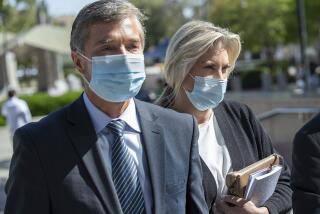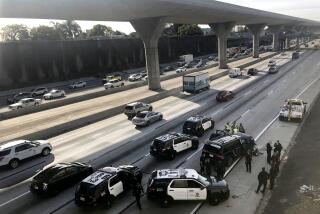When worlds collide
- Share via
WE DIDN’T LIKE “THE ISLAND,” but on principle we have no objection to the sight of Scarlett Johansson being chased by futuristic flying motorcycles, as she was in that film. When she gets chased to Disneyland by four SUVs loaded with paparazzi, though, somebody’s got to draw the line.
Johansson’s car crashed into a vehicle carrying a woman and her two young daughters last week near Disneyland, apparently while the actress was trying to elude a school of camera-toting remoras who tailed her from her Hollywood home. No one was injured -- this time.
It’s hard to tell whether the paparazzi are getting more aggressive or the media are just paying more attention. Ever since a photographer crashed his car into Lindsay Lohan’s Mercedes-Benz in West Los Angeles in May, allegedly in order to get candid shots of the actress’ post-crash trauma, there has been a new paparazzi story seemingly every week. Besides Lohan and Johansson, there is Reese Witherspoon, who allegedly was trapped at her gym by photographers who then chased her by car to the gates of her secure community off Sunset Boulevard.
Where there’s media and movie stars, there are politicians and prosecutors. The L.A. County district attorney’s office is investigating the feasibility of filing conspiracy charges against paparazzi who endanger celebrities or others. State Assemblywoman Cindy Montanez (D-San Fernando) has introduced a bill that would allow people who are assaulted or intimidated by paparazzi to sue for damages.
Yet there already are laws against assault, and Montanez’s bill doesn’t clearly distinguish between paparazzi and legitimate news photographers. (It’s not necessarily her fault: the distinction can be hard to make.) The D.A.’s approach might be more successful, but few cases of paparazzi harassment rise to the level of criminal activity, let alone conspiracy.
Part of the reason this problem is so intractable is economics: As long as the demand for a product (celebrity photos) is greater than the supply, there will be those (the paparazzi) willing to take great risks to supply the product. One way to solve this problem, then, would be to ask celebrities to make themselves more available. Another way would be to ask the media who use the paparazzi’s photos to devote more coverage to other things. (In next week’s Star: Behind the scenes at the WTO.)
Unfortunately, neither of these prospects is too realistic. The best solution, unsatisfactory as it may be, is for the paparazzi to better police themselves. Many are independent, but most work for established photo agencies that at least claim to have professional standards. Those standards should include a ban on car chases, which endanger the general public in addition to the photographers and their prey.
More to Read
Only good movies
Get the Indie Focus newsletter, Mark Olsen's weekly guide to the world of cinema.
You may occasionally receive promotional content from the Los Angeles Times.










